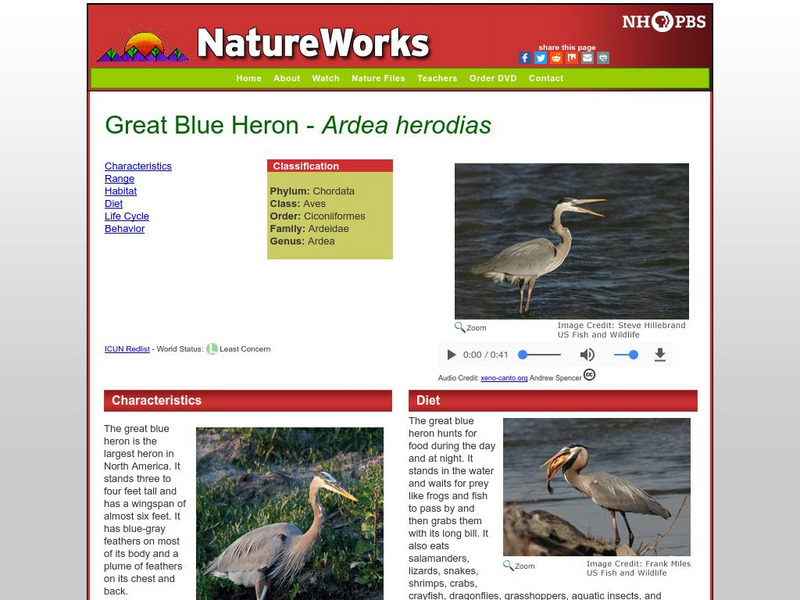Curated OER
Spot the Differences: Great Blue Herons
In this science and visual discrimination worksheet, students spot 6 differences between the two pictures of the great blue heron.
Curated OER
Drawing - Swan Lesson and the Blue Heron Lesson
Students draw a swan and heron from step-by-step instructions. They discuss characteristics of the swan and its environment. Students study and write a paragraph, story, or report illustrating their picture.
Curated OER
Maze- Help the Heron Find Its Way Out of the Forest
In this science maze activity, students read a short description of the great blue heron before completing a maze. They help the heron find its way through the forest to the shoreline to complete the maze.
National Endowment for the Humanities
Lu Shih — The Couplets of T’ang
Writing poetry in ancient China was the modern equivalent of sending a greeting card. Scholars learn about the ancient Chinese poetic form called the lu shih. They read about the context of poetry during the T'ang Dynasty and complete a...
American Museum of Natural History
Life in the City
Believe it or not, biodiversity exists even in areas of disturbed habitat. An interactive activity challenges learners to look for species with a magnifying lens in an image of a city habitat. Pop-up images and descriptions explain how...
Curated OER
Flip Camera Lesson: Louisiana Animal Adaptations
Young scholars research and present information about Louisiana animal adaptations. In this animal adaptation and video camera lesson, students choose an animal from a teacher prepared list. They use the Internet to find five adaptations...
Curated OER
Pond Life
Environmental explorers create an experiment related to ponds and then present their finding to the class. This resource is extremely open-ended. It needs more concrete objectives and procedures for meeting them.
PreKinders
Colors of Nature
The colors of nature are the most beautiful and vivid colors in the world. Show kids the ways that colors are striking and changing throughout different habitats with a set of images that feature two animals or plants for each color.
Curated OER
Salt Marsh Plants and Animals
In this salt march plant and animals instructional activity, students read descriptions of animals, then match each to its picture. Students then read about tidal animals and choose which animals in picture are most likely to be in a...
Curated OER
Waterfowl Word Search
In this science worksheet, young scholars find the names of 14 waterfowl in a word search puzzle. The word bank has a detailed color drawing of each bird.
Curated OER
Birds: Wetlands Ecosystems
In this birds activity, students click on the links to learn about the birds of the Wetlands and answer short answer questions about it. Students complete 7 questions total.
Curated OER
Birds of Wetlands Facts Table Activity
In this birds of wetlands worksheet, students create a table on the internet to insert facts of the birds in the wetlands. Students make a table for 9 birds.
Curated OER
Social Studies: Classroom Culture
Sixth graders compose a list of classroom cultural values. They begin with a list of unacceptable behaviors. Each student presents two ideas they think should be part of the class culture. Students try to persuade classmates to accept...
Curated OER
Rock-a-bye Babies in a Wetland
Students review the way human babies grow and what type of care they need. Using the internet, they are introduced to five different wetland habitat animals and how their babies grow. They discover how they are born and what the...
Curated OER
Animal Tracks
Pupils are introduced to the topic of area. In groups, they share various techniques to help them identify different shapes and work together to calculate the area. They use this same knowledge to determine the area of animal tracks...
Curated OER
Who Lives in a Wetland?
In this science worksheet, students list the names of 14 animals that live in a wetland. The animals are pictured and numbered. Students identify the animals and color the picture.
Curated OER
Marine & Aquatic Habitats Activities - Estuaries Are for the Birds!
Students recognize that birds act as indicators of pollution because of their sensitivity to environmental change, and role play the manner in which marine debris can be hazardous to waterfowl.
Curated OER
Critters in Your Own Backyard
Learners identify various animals and their habitats, as well as their specific traits In this animal habitat lesson, students list animals they've seen in their backyard. Learners select one animal and do research. Students then answer...
Canadian Wildlife Federation
Hinterland Who's Who: Great Blue Heron
Canadian Wildlife site features the Great Blue Heron. Highlights its habitat and habits, range, feeding and breeding characteristics.
Royal Canadian Geographical Society
Canadian Geographic: Animal Facts: Great Blue Heron
Learn fast facts, the physiology, habitats, behaviors and range of the great blue heron.
PBS
Nh Pbs: Nature Works: Little Blue Heron
Find out more about the Little Blue Heron through this educational resource. The content of this source includes information on behavior, characteristics, life cycle, diet, habitat and range.
PBS
Nh Pbs: Nature Works: Great Blue Heron
This overview provides students and teachers with a brief description of the Great Blue Heron. The content of this resource includes information on the behavior, life cycle, characteristics, habitat, range and diet of the aquatic bird.
Nature Canada
Nature Canada: Great Blue Heron
The great blue heron ranges all over North America and into the Caribbean and northern South America. Its population is healthy at this time.
Chicago Zoological Society
Chicago Zoological Society: Zoo Explorer: Little Blue Heron
Get to know the little blue heron by browsing this brief summary from the Brookfield Zoo. This animal guide offers quick facts, a photo, and information on the appearance, social behaviors, and mating habits of these colonial nesters.






















